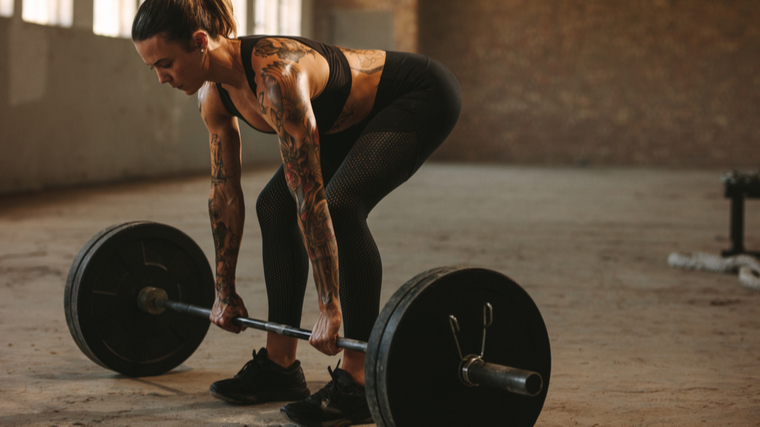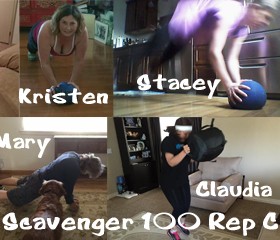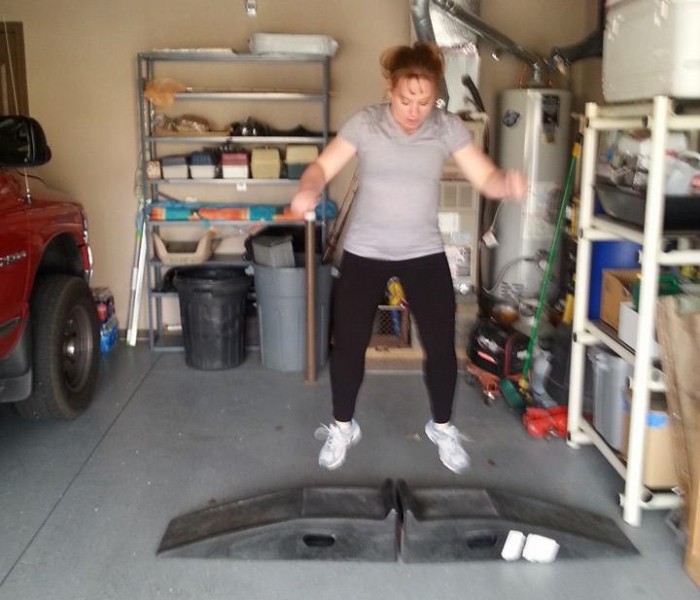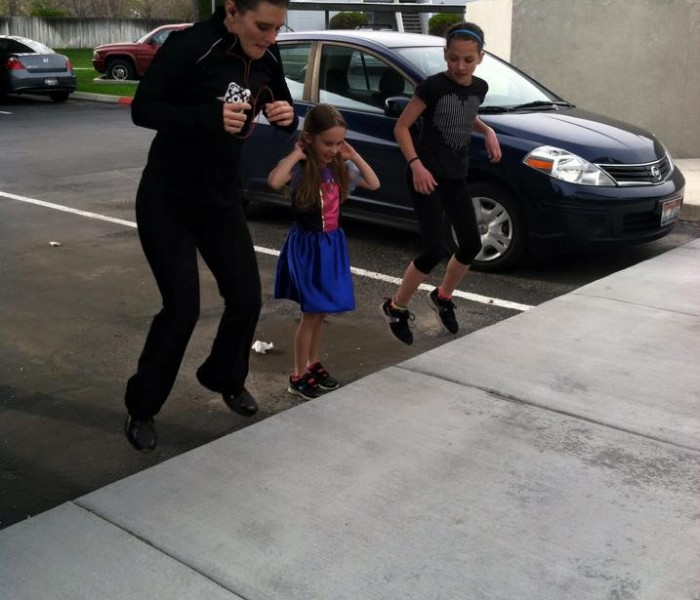http://www.marksdailyapple.com/
 You’ve probably seen a BOSU exercise ball at the gym. It’s that piece of equipment hanging out by the free weights that looks like half of an inflated beach ball about two feet in diameter attached to a flat disc. You know the one. But do you know what to do with it? Have you ever incorporated a BOSU ball into your workout?
You’ve probably seen a BOSU exercise ball at the gym. It’s that piece of equipment hanging out by the free weights that looks like half of an inflated beach ball about two feet in diameter attached to a flat disc. You know the one. But do you know what to do with it? Have you ever incorporated a BOSU ball into your workout?
The BOSU ball is actually one of the more versatile items in the gym. This one apparatus can train the upper body, lower body, core, balance and stability, and it even provides a great cardio option if you know how to use it to get your heart rate up. When you’re traveling, if all the meager hotel gym has is a BOSU ball and a mat, it’s easy to devise a total body workout that will have you sweating.
Get started with this list of 12 simple exercises you can do with just a BOSU ball and your body weight, plus variations to make them easier or more challenging according to your fitness level. As always, check with your physician if you have concerns about starting a new exercise program. Folks who struggle with their balance may want to ask a trainer or coach to help get them started.
12 BOSU Ball Exercises
These are roughly broken down into core exercises, upper body exercises, lower body exercises, and “cardio.” The beauty of the BOSU ball, though, is that every exercise is really a full-body exercise. The BOSU’s instability (I believe “wobbliness” is the technical term) means that muscles throughout your body are called upon to stabilize and help you hold each position. Make sure to keep your core contracted throughout each of these exercises.
Each exercise has a suggested time or rep range that constitutes one set. Adjust these to your capabilities. Options for using these exercises to create a whole body workout are in the next section.
Note: “Platform side down” means the flat side of the BOSU is on the ground, dome (ball) facing up. “Platform side up” means the dome side is down, flat side facing up. The BOSU is obviously more stable when the platform is on the ground, making exercises easier. Be advised that the BOSU ball has a weight limit of 300 to 350 pounds (136 to 159 kg), depending on the model.
Core exercises
BOSU BALL PLANK

Place the BOSU platform side down. Put your elbows on top of the ball at approximately shoulder width. Keep your shoulders directly over elbows as you walk your feet back until you are in a plank position with core contracted. Hold for 30 to 60 seconds.
Variations: If this is too difficult, place your knees on the ground. Place your hands on the ball instead of elbows. To make it harder, alternate lifting one foot at a time off the ground. For an advanced version, turn the BOSU over so its platform side up. (See push-up section below for position.)
BOSU BALL SIDE PLANK

Place the BOSU platform side down. Place your right elbow on the ball and walk your feet out so you are in a side plank position with left foot stacked on top of right. Left hand can be on your hip or extended towards the ceiling. Hold this position for 30 to 60 seconds. Repeat on the other side.
Variations: Dip your bottom hip toward the ground and return to plank position. Keep doing this for the duration of the set. To make this easier, bend your bottom leg and rest your bottom knee on the ground.
BOSU BALL V-SITS

Place the BOSU platform side down. Sit on top of the ball with your hands slightly behind your hips. Bring your knees to your chest. Keep your feet together as you extend your legs out in front of you, then bring your knees back into your chest. Repeat for 30 to 60 seconds.
Variation: Really challenge your balance and core by reaching your arms straight out in front of you instead of using them for support.
Upper body exercises
BOSU BALL PUSH-UP

The push-up is one of the Primal Essential Movements, along with the plank. Place the BOSU platform side up. Start in a plank position with hands flat or gripping the edges of the platform. Lower your chest toward the platform using control to try to keep the BOSU from wobbling too much (it will wobble a little no matter what you do). Aim for 8 to 20 reps.
Variations: For an easier version, place your knees on the ground. To make it harder, alternate lifting one foot at a time off the ground. Place your toes on the BOSU and your hands on the ground instead.
BOSU BALL STAGGERED PUSH-UP

Place the BOSU platform side down. Place one hand in the middle of the ball and the other hand on the ground so they are slightly wider than shoulder width. Assume the plank position and lower your body towards the ground as in a traditional push-up. Aim for 8 to 20 reps.
Variations: Drop your knees to the ground to make it easier. This is already a very challenging exercise, but you can dial it up even more by alternating hands every time. Start with your right hand on the ball and left hand on the ground. Do one push-up. Then bring your left hand onto the ball and walk your right hand down to the ground. Adjust your feet as necessary, then do another push-up. Continue to walk your hands back and forth over the ball, alternating push-ups on each side.
BOSU BALL QUADRUPED HOVER

Place the BOSU platform side up. Kneel in front of the BOSU with your feet flexed so you are resting on your toes instead of the tops of your feet. Grasp the edges of the platform with your hands so you are in something like an all-fours position. Lift your knees off the ground, making sure to keep shoulders over wrists. Hover for 30 to 60 seconds.
Variation: Lift one foot at a time an inch or two off the ground and hold it for a few seconds before switching sides.
Lower body exercises
BOSU BALL SPLIT-LEG LUNGE

Place the BOSU platform side down. Stand about 12 inches in front of the BOSU. Reach back with your left foot and place the toes in the middle of the BOSU ball. Keep most of the weight in your front (right) foot. Adjust your stance so you are in a comfortable position to lunge, then bend your knees and lower down until your right thigh is parallel to the ground, keeping your right knee tracking over your toes. Stand back up. Do 15 to 20 lunges on the right leg, then switch sides and repeat.
Variation: Stand facing toward the BOSU. Place your front foot in the center of the BOSU ball and keep your back foot on the ground instead. Lower and stand slowly and with control because this version is considerably less stable.
BOSU BALL SIDE LUNGE

Place the BOSU platform side down. Stand about 18 inches to the side of the BOSU. Step on the ball with the foot closest to the BOSU, landing your foot in the center of the ball. Keep your standing leg mostly straight and lunge toward the foot that is on the BOSU ball, tracking your knees over toes. Push up to return to standing. Do 15 to 20 squats on one side, then switch sides and repeat.
Variation: Lunge toward the foot that is standing on the ground instead. Turn this into a squat by bending both legs and sitting down toward the ground instead of lunging to the side.
BOSU BALL GLUTE BRIDGE

Place the BOSU platform side down. Lay on your back with knees bent, feet resting in the center of the ball, and hips close to the BOSU. Press into your heels to lift your hips until your torso and thighs form a straight line. Lower your hips back down to the ground with control. Do 15 to 20 reps.
Variations: To make this easier, lie with your upper back on the BOSU ball and your feet flat on the ground with knees bent. To make this harder, try single-leg bridges. Lift one foot off the ball and straighten that leg. Do 15 to 20 reps on the first side, then switch feet and repeat. Expect to feel it in your hamstrings the next day! Keep your arms straight by your sides, hands palm down for stability as shown. Or, for more of a challenge, raise your arms straight toward the ceiling.
Cardio exercises
BOSU BALL MOUNTAIN CLIMBERS

Place the BOSU platform side up. Hold on to the edges of the platform and assume a plank position as if doing a push-up. Bring one knee toward your chest, then return it to starting position. Do the same with the other knee. Go back and forth for 30 to 60 seconds. Speed it up to increase the intensity.
Variation: Instead of driving your knees straight forward towards your chest, bring them across your body towards the opposite shoulder. This will target the obliques more.
BOSU BALL SIDE-TO-SIDE HOP OVER

Place the BOSU platform side down. Stand about 12 inches to the side of the BOSU with your right foot in the middle of the ball, knees slightly bent. Push into the right foot to travel, or “hop,” over the ball. You will end up standing on the opposite side of the BOSU with your left foot on top. Alternate back and forth for 30 to 60 seconds. Go slower or faster to vary the intensity.
Variation: For an easier version of this exercise, stand with the BOSU in front of you and alternate tapping your right foot then your left foot on the BOSU.
BOSU BALL BURPEE

Everyone’s favorite exercise! Place the BOSU platform side up. Start in the push-up position holding on to the sides of the platform. Step or jump your feet close to your hands. Stand up and do a shoulder press to lift the BOSU over your head. Reverse the motion and step or hop your feet back to plank position. That’s one rep. Keep going for 30 to 60 seconds.
Variation: Take out the shoulder press and just do a traditional burpee where you let go of the BOSU as you stand up and jump straight up in the air. Bend forward, grab the edges of the platform, and step or hop your feet back to plank position.
BOSU Ball Workouts
Always start with a warmup of at least five to ten minutes of easy movement—walking briskly or using a stationary bike, elliptical, or stair climber, for example—to elevate your body temperature and wake up the muscles and joints, so to speak. Follow this with some dynamic stretching movements such as hip circles, arm circles, easy lunges, and pulling your knees toward your chest.
Once you’re warmed up and ready to go, there are numerous ways you could formulate a workout out of the 12 exercises above. Here are three ideas:
Full-body BOSU workout:
- Pick one core, one upper body, one lower body, and one cardio exercise from the lists above.
- Do one set of each exercise, doing the four exercises back to back. That’s one circuit.
- Rest for a minute or two, then repeat.
- Do a fixed number of circuits (four to six is a good target), or do as many circuits as you can in 20 or 30 minutes.
Full-body BOSU ladder:
Pick one core, one upper body, one lower body, and one cardio exercise from the lists above. Do each of the four exercises back to back for 60 seconds each. Then do them again in the same order for 50 seconds each, then 40 seconds each, 30 seconds, 20 seconds, and 10 seconds.
That’s your descending ladder. This is higher-intensity than the full-body workout above because you are going non-stop for about 15 minutes, but you can also rest for 30 seconds to a minute between circuits (or “rungs”) if you need.
If you want even more work, do ascending and descending ladders. Start by doing each exercise back to back for 10 seconds each, then 20 seconds, then 30 seconds, and so on up to 60 seconds, then work your way back down.
Tabata-style workout:
Choose any of the exercise above. Do the movement for 20 seconds, then rest for 10 seconds. Repeat this pattern—20 seconds work, 10 seconds rest—eight times for a total of four minutes. That’s it!
What do you think, folks? Do you use a BOSU ball in your workouts already? What’s your favorite way to use it?
The post How to Work Out with a BOSU Exercise Ball appeared first on Mark’s Daily Apple.


 Looking for a warm and cozy meal? Our beef stew is the perfect meal to cook for a dinner spent inside. Filled with plenty of vegetables, such as radishes and carrots this stew can be cooked on the stovetop or in the oven for ease. Not only is this Keto Beef Stew great on its own, you can easily top it on cauliflower rice or mash.
Looking for a warm and cozy meal? Our beef stew is the perfect meal to cook for a dinner spent inside. Filled with plenty of vegetables, such as radishes and carrots this stew can be cooked on the stovetop or in the oven for ease. Not only is this Keto Beef Stew great on its own, you can easily top it on cauliflower rice or mash.






 For now classes are 6pm and 640pm at 2840 Wildwood st in the Boise Cloggers studio.
Book your class NOW!
click this ==>
For now classes are 6pm and 640pm at 2840 Wildwood st in the Boise Cloggers studio.
Book your class NOW!
click this ==>








